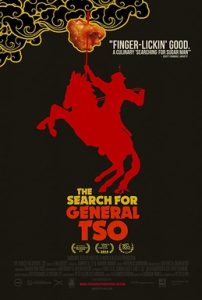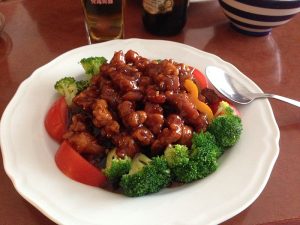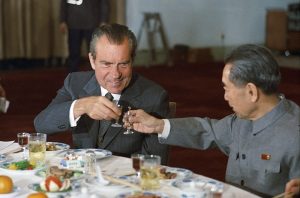
The Search for General Tso is a documentary film that dives into how Chinese cuisine has adapted to American culture in order for the culture to survive in a hostile environment. The film touches on how Americans do not seek authenticity but instead want a window into the culture while staying within their comfort zone.
Aim and Key Messages
- The main goal of this documentary is to demonstrate the cultural change of the Chinese Identity in the US. It dives into the historical and cultural context of Americanized, Chinese cuisine and what that says about the cultural standards of the US and the perseverance of the Chinese people who immigrated to the US. The overall message of The Search for General Tso is the search for Chinese identity in the US and the steps that brought us here
- The purpose of the film is to demonstrate that authenticity is being less and less valued in the US. The Search for General Tso touches on how Chinese culture slowly became embedded in American culture.
Ideologies
- The Search for General Tso’s Chicken touches on the importance of identity and the history that defines a culture. Emphasis how adaptation has allowed the Chinese culture to survive and become an integral part of the American lifestyle. When Chinese immigrants first arrived in California, they were faced with extreme prejudices and laws that made life for them unbearable. The film describes their struggles and their migration east into other states. According to the film, their style of cuisine is what opened the door for the American people to start to accept them.
- This film takes us through many interviews with Chinese Americans who have adapted to a new way of life. One of these interviews is between the movie producers and the Leong family. The father, David Leong, is the owner of Leong’s Asian Diner, a restaurant located in Springfield Missouri. David tells a story of the hardships he faced after buying his restaurant. The citizens of Springfield rioted and vandalized the restaurant and things escalated to a bombing of the restaurant. David claims that the only way he was accepted into this community was after they tasted his cooking. David also claims that he made Cashew chicken. His son, Wing Wah Leong makes this statement:
“Springfield cashew chicken is not traditional Chinese food, it’s something that’s Americanized and one thing that most of the immigrants from China have learned to adapt.” (33:32).
The Search for General Tso demonstrates the adaptability of the Chinese people and their perseverance that allowed them to live and thrive in the United States.
Key Storylines
The Search for General Tso travelers go from New York, to China, then back to the US. Through this journey, we meet many different people who bring relevant information to the formation of Americanized Chinese food and more specifically, General Tso’s Chicken. The film starts with a Chinese woman preparing a plate of General Tso’s Chicken, in order to make it more appealing for a photoshoot. She takes oil and water to make the dish seem warm and delicious. We then go to a New Yorker, Harry Spiller, who has been collecting all things Chinese restaurant memorabilia. His collection includes chopsticks, magnets, and most importantly, menus. The interview of Harry Spiller is key in understanding the extent to which Chinese culture has embedded itself into the US.
“Menus are like mystery books, you know, they answer a lot of questions and they’re a lot of fun to read but, they end up asking more questions.” (5:47)
The film continues to show many different people with varying inputs on the creating of General Tso’s Chicken, as well as Chinese cuisine abroad. We meet a family that moved to a small town in Louisiana when they were very young, who has created a Chinese restaurant called, Trey Yuen Cuisine of China. However, this restaurant has adapted to the taste of its consumers. While interviewing the head chef and part-owner, Frank Wong, we learn that they have adapted their menu to what the locals want to eat.
“Wherever you go, you know, you not cook for yourself, you gotta cook for what the local people like.” (34:49).
Some of their dishes include, “Louisiana, Chinese gumbo, and Szechuan alligator. The film demonstrates how Chines restaurants have adapted to the taste of the local society.
Towards the end of the film, we meet Mr. Wang, an owner of several successful restaurants in New York, who explains the origins of the General’s Chicken. Mr. Wang claims that he was the first to invent the dish in New York, but he confuses that the idea came from a Taiwanese chef, named, Mr. C.K. Peng. Through these interviews, we learn that the American receipt is highly varied from the original. As Mr. Peng is being interviewed, he looks at pictures of the ‘modified’ General Tso’s Chicken, he states that “It’s the name, but it’s not the dish…These pictures don’t make me feel good… There’s a lot of Americans’ who can’t respect or understand authentic Chinese dishes…This is crazy nonsense.” (59:48). Mr. Peng’s quote is crucial in understanding how Chinese cuisine has been altered from its original form. These storylines help demonstrate Chinese cuisine through the American lens.
Linkage
In class, we have talked about how food can be materialistic as well as symbolic. We can see through this documentary that Chinese food allowed Chinese Immigrants to live and thrive in the U.S. Chinese food represents how Chinese immigrants were able to adapt to the American culture, which at the time, was very prejudiced and hateful towards the Chinese. The film can also relate to foodways, and how the Chinese-Americans changed their them in order to keep up with American tastes. It also dived into the first Chinese immigrants who arrived in the US are were forced to alter their customs and traditions, which plays a huge role in Chinese culture in America. The majority of dished found in Chinese restaurants, in the United States, are hybrids, or simply just American creations of traditional Chinese foods. In the film, the products walk the streets of Shanghai, showing locals a picture of General Tso’s Chicken and none of them recognized the dish. One woman even thinks that the chicken in the photo is actually frog. “It doesn’t look like chicken. It looks like frog.” ( 8:51) she says. This quote demonstrates how much American-Chinese cuisine has changed from the original, authentic cuisine, to a point where it is no longer recognizable to local Chinese people. All of which plays into foodways and what Americans consider Chinese food.

Opinion
Shae:
- This documentary, in my opinion, has nothing wrong with it, no weaknesses. It has a timeline with labels that it goes through when the setting is changed or a different time period has come, and it is very well thought out and organized. When there are breaks in the film, it shows the places and years of which they ‘visited’ and gives all kinds of information about China, Chinese culture, and food from many different countries, restaurant owners, factory workers (as those who make the fortune cookies and the ‘thank you’ to-go paper containers), and more. The film introduces people, such as Guinness World Record holder Harley Spiller & executive director of the Chinese Historical Society Sue Lee, and their restaurants, such as Sing High Chop Suey House and owner Harlan Lee, and even gets an interview with the man who created General Tso’s Chicken C.K. Peng, his son Chuck Peng, and a 5th generation Grandson of General Tso himself Liang Xiao Jin. The film goes back and forth through not just these few people, but many others, and has you (the viewer) go on these crazy and wonderful journeys with the producers and excursionists.
- The documentary also includes footage and commentary on Former President Nixon’s visit to China in 1972. Nixon drank a type of liquor, Maotia, what we would call 120 proof, with the Chinese people, ate with them, and had all of America watch live. They interviewed one woman and her husband in particular, Cecilia and Philip Chiang, on what life was like for them when they came to America in the 1950’s and how Nixon’s visit changed their business. When asked what the Chinese food was like once they arrived, Cecilia responded with, “it just taste so — pretty bad.” After that, and once the story of Nixon visiting China was told, Cecilia said right after that people would come into The Mandarin (her restaurant) and asked “can you duplicate Nixon’s diner?” Then suddenly all these Chinese restaurants had people lined up outside their doors.
- This documentary has so many incredible storylines and experiences. It felt as if you were there when everything was going on. It seemed a bit boring at first, but as it went on and as I got to experience the emotions I did in this film, I became intrigued and overall, this is a fantastic film.

Jacob:
- I found the film to be very informative and interesting. The director blended comedic elements as well as relevant information in order to keep the audience entertained, while also informing them on a topic that I’m sure most people don’t think about. It was very in-depth and brought up interesting concepts and ideas surrounding Chinese heritage and identity. The documentary also demonstrated how things are altered through the years in order to stay relevant. The film also made me somewhat uncomfortable, it is never pleasant to realize that you feed into a culture that suppresses the authenticity of another. The film was able to dive into the broader social issues that surround Chinese food in the US. However, I did find at some points that I was lacking interest in certain aspects of the film. There is a scene that talked about the invention of Cashew Chicken, and I found myself asking whether this was relevant to the top of General Tso’s chicken. Similarly, I thought that the storylines ran together and didn’t focus on the dish for which the film is named. However, overall I thought the film is important and relevant in today’s society.
References
- Wikipedia (2014). [The Search for General Tso]
Retrieved April 20, 2014 from https://en.wikipedia.org/wiki/The_Search_for_General_Tso
- Wikimedia (2014). [General Tso’s Chicken]
Retrieved May 31, 2014 from https://commons.wikimedia.org/wiki/File:General_Tso%27s_Chicken.JPG#/media/File:General_Tso’s_Chicken.JPG
- Wikimedia (1972). [US President Richard Nixon and Chinese Premier Zhou Enlai Toast]
Retrieved (from the film) February 25, 1972 from https://commons.wikimedia.org/wiki/File:Nixon_and_Zhou_toast.jpg#/media/File:Nixon_and_Zhou_toast.jpg
- Jennifer 8., Lee. & Amanda, Murray. (Producers), & Ian, Cheney. (Director). (2014). The Search for General Tso [Motion Picture]. United States: Wicked Delicate Films .